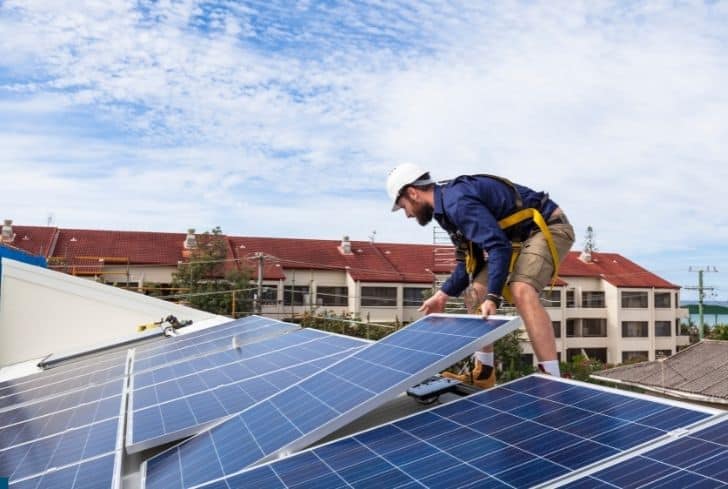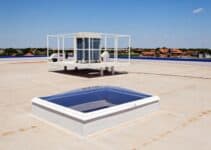There are several valid reasons to consider walking on solar panels. You may be installing them in an area lacking a walkable path, or you’re just low on space.
Solar panels are made of delicate materials, although they look sturdy enough. And manufacturers try to make them with reinforced and durable materials, but too much weight may shatter them. That’s not all – what else can be damaged while walking on solar panels?
The answers may surprise you, so keep reading!
Is It Safe To Walk on Solar Panels?
It’s not always unsafe to walk on solar panels, but there are many reasons we don’t recommend doing so. The risk of electrocution is one of the primary reasons you should avoid walking on solar panels.
If the PVC installation has any inadequate and unsafe wiring, or the back of the modules is lacking, the surface of your solar panel is a danger zone. Walking on it exposes you to the electric shock caused by DC currents, which are potent and dangerous.
Furthermore, when you put excessive weight on your solar panels, you may scratch the frames, glass, or cells. This technology is expensive, and when you damage one of the photovoltaic cells, it reduces the efficiency of your solar system.
Additionally, the cracks may widen because of the changing weather elements. The materials may also contract or expand, eventually breaking away.
The crevices may widen as thermal expansion and contraction occur, and finally, the material separates.
Although this sustainable energy source is a financial godsend, in the long run, you will break the panels when you walk on them. And aside from the substantial amount it costs to install these solar fixtures, maintaining them also requires significant effort. When heavy footwear treads these surfaces, you’ll undo your work and rack up unreasonable and unnecessary costs.
Solar panels typically last two decades, and they’re sturdy enough to withstand harsh elements like snow, rain, and thunderstorms. They may be strong enough to carry your weight, but when you move on the panels, the story changes.
Walking on them constantly spoils the cell surface and accelerated efficiency degradation. If you’re left with no choice but to walk on the panels, it’s best to avoid putting more than fifty pounds of weight on each square foot.
You must also be mindful of where you place your foot and how much force you use. Putting it in the wrong place with too much pressure may damage the photovoltaic cells.
Other reasons it’s not ideal to walk on solar panels are:
- The surface is smooth and lacks traction.
- Your movement may block sunlight access to the surface, and when there are insufficient protons, there won’t be an efficient charge.
- You’ll also be adding unnecessary stress and weight to your roof.
- The panels are slippery; you may fall if you’re not careful.
- Solar panels are also often hot to the touch, especially when the sun is blazing.
How Much Weight Can Solar Panels Handle?
Solar energy has improved in efficiency and affordability over the years, and there are many more users than there were during the last decade. However, some things are still unclear about this technology, such as how much weight the panels can handle.
Technically, a solar panel can handle less than the weight of an average man, which is about 200 pounds. More specifically, it holds a maximum of 50 to 75 pounds per square foot area, which is almost inadequate for your weight or that of the contractor installing the panels.
You can only lean on them, not put your whole weight.
Nonetheless, the weight solar panels hold may also be determined by the materials used to make them.
Now, another thing you should consider when you next experience the urge or need to walk on solar panels is that the weight they can handle isn’t dependent on just what you weigh but also on the equipment that’s on them. Their ability to bear weight reduces with the more items on each square foot.
Moreover, some solar panels can handle the weight of moving cars. And you can even walk or move your bike on them. An example is a solar roadway, which can hold about 250 tons.
How Can Solar Panels Get Damaged by Walking On Top of Them?
It’s no secret that walking on solar panels, particularly domestic ones, is not recommended. They may supply two to three decades of robust solar energy, but walking on them will reduce their efficiency over the years.
Here are ways solar panels get damaged by walking on top of them:
1. Scratching the Glass
If you wear outdoor shoes on solar panels, walking on the surface can scratch the glass because of the shards and stones that may be stuck in the sole. The scratch causes a reduction in power generated by the PV system. And the damage depends on the depth and severity of the scratch.
You need an expert to fix this problem if you’re already experiencing it.
2. Smudging the Glass
Smudging the glass is another risk of walking on solar panels. If your shoes are dirty, this is very likely. And when that happens, the dirt blocks the potency of sunlight that hits the solar cells.
This may eventually affect power output. Clean the surface if this is the case.
3. Breaking a Solar Cell
The weight solar cells can handle is unsurprisingly low, considering how delicate these components are. Sure, the tempered glass surface of the panels may protect them, but when too much weight is applied, such as walking on them, the solar cells are endangered.
You’ll notice a dwindle in output power performance if you’ve made this mistake and broken some photovoltaic cells. The decrease will be more noticeable over time; call a technician for this.
4. Breaking Busbars
The issue of breaking busbars located in-between photovoltaic cells also arises when you walk on solar panels. They’re located within the PV module, dedicated to ensuring the smooth passage of electricity from one cell to another and from one panel to the next.
And when you break one, the PV module may overheat. Disconnect the panel or replace the module to fix this problem.
What to Do if Your Solar Panels Break?
If your solar panels break, it’s essential to invite a capable installation company without delay. The damage will undoubtedly worsen over time as the crystalline cells become more exposed.
Repairing it will help you protect the photovoltaic cells and other delicate components from moisture and further damage.
Now, if you have insurance for your solar panels, check if there’s coverage for damage caused by walking on the surface before submitting your claim. If a company installed the fixtures for you, invite them to inspect the area and determine how much damage has been done.
You won’t need to add additional insurance coverage for a broken solar panel, provided it’s still attached to your roof. You’ll be indemnified against damage caused by weather elements like fires, windstorms, and thunderstorms. But again, your insurance provider may examine the cause of the damage and refuse to repay you in some instances.
However, if the crack is minor, you may be able to fix it yourself. For instance, waterproof resin or polyurethane creates a waterproof layer that protects exposed solar cells. It’ll peel over time, so this should only be a temporary solution.
Another option is a laminating film – when you apply it appropriately, it delays damage caused by cracks.
Do you Need to Walk on Solar Panels to Clean Them?
We’ve established that walking on solar panels is an unwise investment decision, so how are you supposed to clean them? Well, you can check the strength of the materials used to make yours. Even if it can handle significant weight per square foot, you can still clean them without walking on the surface.
Now, here’s a suitable way to clean solar panels without damaging them:
- Always use a low-pressure hose to rinse off the dirt.
- Pour some warm water and non-abrasive detergent or liquid wash into a spray bottle.
- Wipe the borders with a lint-free cloth after spritzing an appropriate cleaning agent on them.
- Use an extended squeegee to reach the top parts of the glass.
- Attach a nozzle to your garden hose for spraying the panels.
- Don’t forget to check for cracks while cleaning. This helps you control the potential damage before it expands.
But again, if you’re uncomfortable with cleaning the panels yourself, don’t hesitate to contact the chore to a company.
Can a Broken Solar Panel Work?
A broken solar panel may work; it’ll still function when it breaks, even though the efficiency will be affected. It’s best to fix it immediately to avoid worsening the situation through exposure to weather elements.
Solar panels can last more than 25 years with good maintenance. But if storms and other threats to the panels are more common where you reside, it increases the chances of the tempered glass surface breaking.
High winds can also do significant damage, primarily through falling twigs and branches. It can shatter the glass, but a protective cover can mitigate this danger.
You can also waterproof the surface of the panels to hold up better in the monsoon season. Moreover, all these precautionary steps are best combined with treating the solar panels as delicate items.
They will help you save costs because if the surface crack is significant, you may need to replace the entire thing.
Will Walking on a Solar Panel Void Their Warranty?
There are many reasons you shouldn’t walk on a solar panel, starting with the fact that they weren’t designed to be walked on. The dirt from your shoes is also a concern, but that can even be hosed away.
However, smaller debris like a tiny shard, stone chips, and grit can get stuck in strategic places, becoming a problem later. Besides, these sharp objects can scratch the surface of the solar panels, puncturing photovoltaic cells and reducing the system’s efficiency.
Your insurance provider will take care of a broken solar panel, depending on the circumstances. Before raising a claim, you must be certain that the damage wasn’t caused by carelessness or negligence, such as walking on the panels.
Walking on solar panels will void your warranty if any damage happens. And even hiring unlicensed technicians to work on or clean them may dislodge the validity of your claims.
Conclusion
Walking on solar panels isn’t always risky; well, not really for you. However, this act can damage the photovoltaic cells, busbars, and even tempered glass. Regardless of how valid your reason for walking on your solar panels is, we urge you to consider alternatives instead.
Solar technology is reasonably costly, but maintaining it is also easy. Moreover, actions like walking on the fragile glass will accelerate deterioration.






